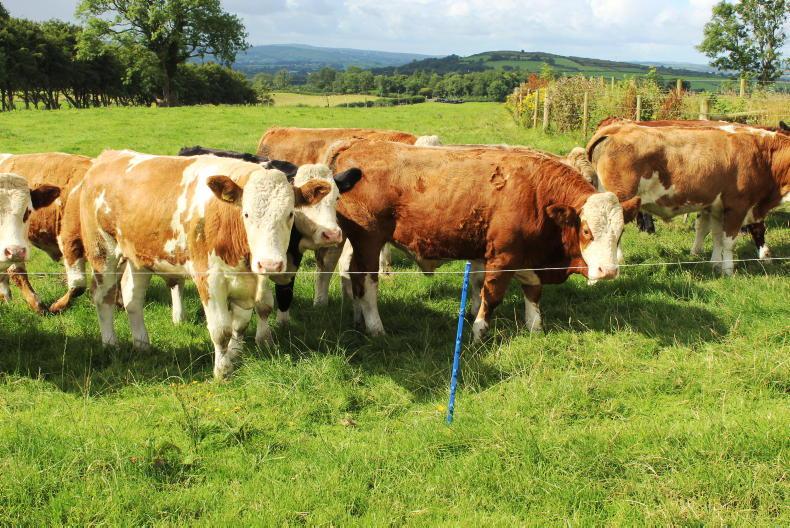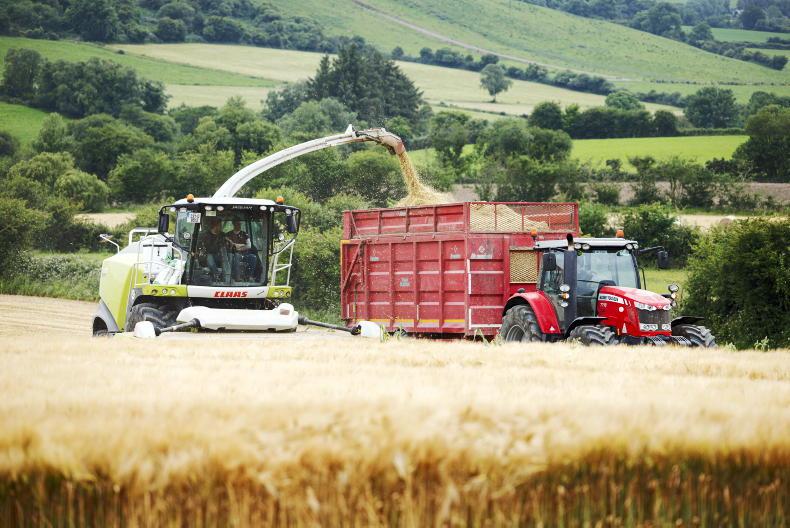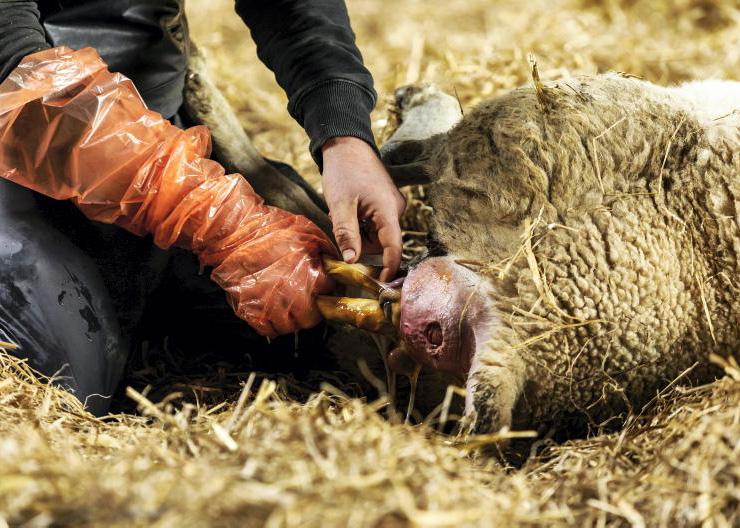John McCay farms outside Castlederg, Co Tyrone with his father Billy and son Matthew. The 470 acre grassland unit carries a dairy herd with 300 Fleckvieh cows managed in two block-calving periods.
The majority of the herd is spring-calving, with 240 cows calving inside 12 weeks from the start of January. The other 60 cows calve from 1 October to 1 December.
The split calving profile makes herd management easier and means there are milk sales every month of the year.
Herd yields are 6,300l/cow at 4.37% butterfat and 3.32% protein, giving 520kg of milk solids per cow.
Concentrate use is around 50% of the average dairy unit in Northern Ireland at 1.2t/cow fed annually. This gives a milk yield from forage of 3,660l/cow, more than twice the NI average.
With the predominantly spring-calving nature of the herd, grazed grass plays a huge role in driving milk output from the cows.
The farm extends to 320 acres located in and around the home yard, which is used for grazing and silage.
The remaining 150 acres is located on a fragmented outfarm around five miles from the home yard and is used for grazing herd replacements, plus male progeny any time the herd is under movement restrictions for TB.
The outfarm is a mix of land types and lies close to the Tyrone-Donegal border. There is productive grassland grazed by heifers and some large swathes of rougher, overgrown pasture with rocky outcrops.
Over the past couple of years, John has undertaken a reclamation project to bring parcels of ground on this land block back in to production.
Renewable energy
The farm also makes use of renewable energy, with 150kW and 250kW turbines installed in recent years, one of which is on the home unit and the other on the outfarm.
Changing cow type
Fleckvieh genetics were introduced to the farm in 2008 following a trip to Germany.
The herd had previously used a Holstein Friesian cow, but fertility was a huge problem that John was struggling to get on top of.
Most years, empty rates after breeding could be as high as 30%. Culling for feet, age or poor performance was on top of this.
It was Billy who initially saw Fleckvieh cows being milked in Germany and on his return, the decision was taken to give the breed a chance.
Stock has been built up over the years using Fleckvieh semen following the initial purchase of calves and in-calf heifers. The current cow is a Fleckvieh cross as there is still some Holstein breeding in mature cows.
Since changing breed type, empty rates have dropped to 8% after a 12-week breeding period, which is impressive as cows are served to natural heats.
Reclaiming grassland on the outfarm
Over the last three years, John has set about reclaiming the roughest 20 acres of ground on the outfarm.
The land itself was inherited from a family member and as a consequence of under-grazing, ground had reverted to a natural state dominated by gorse and weed grasses.
A lack of internal fencing meant cattle ranged over most of the ground unimpeded, which again, did little for the grasses present.
Starting point
The project started in 2019 with 11 acres reclaimed. Soil tests were taken and pH levels were at 5.4 with phosphate (P) and potash (K) levels at 2 and 1 respectively.
Large parts of the 11 acres had a lot of rock present, both protruding from the ground and lying under a shallow depth of topsoil. This made ploughing impractical.
Instead, John employed a contractor with a track digger and mulcher to clear back overgrown vegetation and some drains were installed to remove water from hollow spots. Soils were then cultivated using a heavy set of discs to create a tilth for drilling grass seed.
Liming
To address soil fertility, lime was required but the recommended rate was excessive for a single application.
Therefore, John decided to try something different to get a higher neutralising effect in one dressing.
First off, he applied 2t/acre of ground limestone on the 11 acres. This was then topped up with 150kg/acre of an alternative liming product made from egg shells that had been dried and milled using wind energy.

After mulching ground, discing and reseeding in 2019, the 11 acre block is now laid out in paddocks and used to graze male progeny from the dairy herd.
Known as eco eggshell, the product is a soil conditioner and research undertaken at Iowa State University indicated that egg shells have a calcium content between 90% and 95%, which is twice the calcium content of ground limestone.
At the time of application, it cost £100/t which worked out at £15 for the 150kg/acre dressing. The product was applied using the fertiliser spreader, which made it a convenient option for John.
Soil pH
Every year 50% of the farm is soil tested to maximise grass growth for grazing and silage. The 11 acre block that was reclaimed has been tested annually to monitor the effect of lime application on soil pH.
In 2020, soil pH jumped to 6.9 from the 5.4 reading during the previous year. Organic manures have been applied to build up P and K levels, as well as through more controlled grazing.
Soil pH has since settled around pH 6.3, with P rising to index 3 and K now at index 2-. John will continue to soil test annually and intends to reapply the egg shell soil conditioner should pH fall below 6.1.
Further reseeding
John has been impressed with the outcome of the reclaiming work and is now reclaiming another eight acres this week.
He also is planning to reseed 25 acres of the grazing platform on the home farm and will again spread 2t/acre of ground limestone along with 150kg/acre of the egg shell soil conditioner.
If the process produces the same results, John maintains it will be his go-to approach for reseeding in future.

John McCay farms outside Castlederg, Co Tyrone with his father Billy and son Matthew. The 470 acre grassland unit carries a dairy herd with 300 Fleckvieh cows managed in two block-calving periods.
The majority of the herd is spring-calving, with 240 cows calving inside 12 weeks from the start of January. The other 60 cows calve from 1 October to 1 December.
The split calving profile makes herd management easier and means there are milk sales every month of the year.
Herd yields are 6,300l/cow at 4.37% butterfat and 3.32% protein, giving 520kg of milk solids per cow.
Concentrate use is around 50% of the average dairy unit in Northern Ireland at 1.2t/cow fed annually. This gives a milk yield from forage of 3,660l/cow, more than twice the NI average.
With the predominantly spring-calving nature of the herd, grazed grass plays a huge role in driving milk output from the cows.
The farm extends to 320 acres located in and around the home yard, which is used for grazing and silage.
The remaining 150 acres is located on a fragmented outfarm around five miles from the home yard and is used for grazing herd replacements, plus male progeny any time the herd is under movement restrictions for TB.
The outfarm is a mix of land types and lies close to the Tyrone-Donegal border. There is productive grassland grazed by heifers and some large swathes of rougher, overgrown pasture with rocky outcrops.
Over the past couple of years, John has undertaken a reclamation project to bring parcels of ground on this land block back in to production.
Renewable energy
The farm also makes use of renewable energy, with 150kW and 250kW turbines installed in recent years, one of which is on the home unit and the other on the outfarm.
Changing cow type
Fleckvieh genetics were introduced to the farm in 2008 following a trip to Germany.
The herd had previously used a Holstein Friesian cow, but fertility was a huge problem that John was struggling to get on top of.
Most years, empty rates after breeding could be as high as 30%. Culling for feet, age or poor performance was on top of this.
It was Billy who initially saw Fleckvieh cows being milked in Germany and on his return, the decision was taken to give the breed a chance.
Stock has been built up over the years using Fleckvieh semen following the initial purchase of calves and in-calf heifers. The current cow is a Fleckvieh cross as there is still some Holstein breeding in mature cows.
Since changing breed type, empty rates have dropped to 8% after a 12-week breeding period, which is impressive as cows are served to natural heats.
Reclaiming grassland on the outfarm
Over the last three years, John has set about reclaiming the roughest 20 acres of ground on the outfarm.
The land itself was inherited from a family member and as a consequence of under-grazing, ground had reverted to a natural state dominated by gorse and weed grasses.
A lack of internal fencing meant cattle ranged over most of the ground unimpeded, which again, did little for the grasses present.
Starting point
The project started in 2019 with 11 acres reclaimed. Soil tests were taken and pH levels were at 5.4 with phosphate (P) and potash (K) levels at 2 and 1 respectively.
Large parts of the 11 acres had a lot of rock present, both protruding from the ground and lying under a shallow depth of topsoil. This made ploughing impractical.
Instead, John employed a contractor with a track digger and mulcher to clear back overgrown vegetation and some drains were installed to remove water from hollow spots. Soils were then cultivated using a heavy set of discs to create a tilth for drilling grass seed.
Liming
To address soil fertility, lime was required but the recommended rate was excessive for a single application.
Therefore, John decided to try something different to get a higher neutralising effect in one dressing.
First off, he applied 2t/acre of ground limestone on the 11 acres. This was then topped up with 150kg/acre of an alternative liming product made from egg shells that had been dried and milled using wind energy.

After mulching ground, discing and reseeding in 2019, the 11 acre block is now laid out in paddocks and used to graze male progeny from the dairy herd.
Known as eco eggshell, the product is a soil conditioner and research undertaken at Iowa State University indicated that egg shells have a calcium content between 90% and 95%, which is twice the calcium content of ground limestone.
At the time of application, it cost £100/t which worked out at £15 for the 150kg/acre dressing. The product was applied using the fertiliser spreader, which made it a convenient option for John.
Soil pH
Every year 50% of the farm is soil tested to maximise grass growth for grazing and silage. The 11 acre block that was reclaimed has been tested annually to monitor the effect of lime application on soil pH.
In 2020, soil pH jumped to 6.9 from the 5.4 reading during the previous year. Organic manures have been applied to build up P and K levels, as well as through more controlled grazing.
Soil pH has since settled around pH 6.3, with P rising to index 3 and K now at index 2-. John will continue to soil test annually and intends to reapply the egg shell soil conditioner should pH fall below 6.1.
Further reseeding
John has been impressed with the outcome of the reclaiming work and is now reclaiming another eight acres this week.
He also is planning to reseed 25 acres of the grazing platform on the home farm and will again spread 2t/acre of ground limestone along with 150kg/acre of the egg shell soil conditioner.
If the process produces the same results, John maintains it will be his go-to approach for reseeding in future.













SHARING OPTIONS